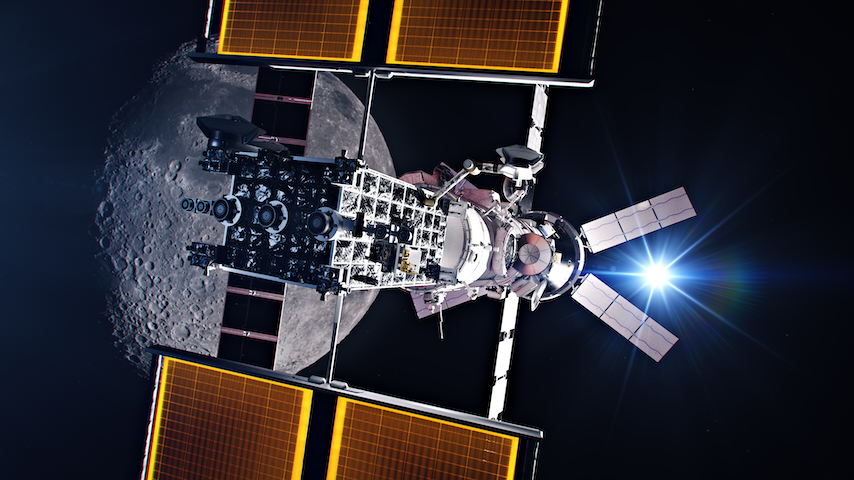Spotlight on NASA Spaceflights
Spotlight on NASA Spaceflights


Space exploration requires years of development to go from concept to launch pad. Here is a quick look back at the timelines of four landmark NASA programs.
In the hopes of returning astronauts to the moon for the first time since 1972, Space Policy Directive 1 established NASA’s Artemis program in 2017. Although Artemis I—an uncrewed mission to orbit and pass the moon—launched successfully in 2022, the next two missions have hit a speed bump.
On January 9, NASA announced that Artemis II and Artemis III will take place later than expected. Instead of 2024, Artemis II, the first crewed mission around the moon, will aim for a September 2025 launch.
The agency reported that crew safety was the main reason for the delay, mentioning specifically issues related to the environmental control and life support systems required to support astronauts that still need to be resolved.
Meanwhile, Artemis III, which will put astronauts on the moon’s South Pole, was pushed out from 2025 to September 2026. The next two missions will also bring astronauts to the moon but remain on the same schedule for now, with Artemis IV to also bring a lunar space station module to the moon’s orbit in 2028 and Artemis V to add another module in 2029.
As work continues on these missions, here is a quick look back at the timelines of four landmark NASA programs that paved the way for the International Space Station (built from 1998 — 2011) and now, the Artemis program.
With a goal of putting a person into space, Project Mercury kicked off shortly after NASA was created in October 1958.
A total of 20 uncrewed flights followed between 1959 and 1961. Crewed missions began in 1961, starting with Freedom 7, on May 5, 1961, which made Alan Shepard Jr. the first American in space.
Through 1963, a total of six flights carried U.S. astronauts into space, spanning a total combined flight time of 53 hours, 55 minutes, and 27 seconds. These cone-shaped capsules were designed for a single passenger, protected by a heat shield for atmospheric reentry, and equipped with parachutes for their descent into the ocean.
Project Mercury’s final crewed flight launched on May 15, 1963, sending astronaut Gordon Cooper around Earth’s orbit 22 times.
Two uncrewed and 10 crewed missions across this four-year program tested a range of new equipment, helped with navigating procedures on the ground and in the air, and trained astronauts in the build up toward putting people on the moon.
The first Gemini mission was an uncrewed test for the Titan 2 launch vehicle on April 8, 1964.
Gemini III was the program’s first crewed mission, which launched on March 23, 1965. The first to feature a two-person team of astronauts, Virgil Grissom and John Young, the capsule's equipment would help NASA test and understand how spacecraft could dock with another vehicle in orbit. The capsule was more maneuverable as well, allowing the astronauts better control during the mission.
The final mission, Gemini XII, launched on Nov. 11, 1966.
Become a Member: How to Join ASME
One of NASA’s most famous programs coincided with at least part of both of its predecessors and spanned 11 crewed missions, six of which landed on the moon.
The Apollo missions featured three-part spacecraft, featuring a command module (CM) for flight control and crew quarters, a service module (SM) with propulsion and support systems, and a lunar module (LM) for use on the moon that would also launch all three modules back toward Earth.
The Saturn V rocket provided the thrust to send the Apollo missions to the moon, stretching 363 feet tall and weighing 6.2 million pounds when fully fueled. According to NASA, the rocket generated 34.5 million newtons or 7.6 million pounds of thrust at launch. Uncrewed Apollos 4 and 6 were the first to use the rocket in 1967 and 1968, followed by the first crew on Apollo 8 in 1968. Saturn V was used throughout the program and also sent the Skylab space station into orbit during its final launch in 1973.
Initial design concepts for NASA's iconic space shuttles date back to 1968, with the hopes of creating a vehicle capable of being reused for travel to and from space. NASA awarded the first feasibility studies into such vehicles the year after and following more than a decade of development, space shuttle Columbia finally took off on April 12, 1981. It wasn't the first though—that was a shuttled dubbed Enterprise, but it never flew in space and was used for testing purposes.
Over 30 years, shuttles Columbia, Challenger, Discovery, Endeavour, and Atlantis made 134 flights combined, carrying a total of 852 crew members more than 537 million miles to spend 1,320 days in space.
Louise Poirier is senior editor.
On January 9, NASA announced that Artemis II and Artemis III will take place later than expected. Instead of 2024, Artemis II, the first crewed mission around the moon, will aim for a September 2025 launch.
The agency reported that crew safety was the main reason for the delay, mentioning specifically issues related to the environmental control and life support systems required to support astronauts that still need to be resolved.
Meanwhile, Artemis III, which will put astronauts on the moon’s South Pole, was pushed out from 2025 to September 2026. The next two missions will also bring astronauts to the moon but remain on the same schedule for now, with Artemis IV to also bring a lunar space station module to the moon’s orbit in 2028 and Artemis V to add another module in 2029.
As work continues on these missions, here is a quick look back at the timelines of four landmark NASA programs that paved the way for the International Space Station (built from 1998 — 2011) and now, the Artemis program.
Project Mercury (1958 — 1963)
With a goal of putting a person into space, Project Mercury kicked off shortly after NASA was created in October 1958.
A total of 20 uncrewed flights followed between 1959 and 1961. Crewed missions began in 1961, starting with Freedom 7, on May 5, 1961, which made Alan Shepard Jr. the first American in space.
Through 1963, a total of six flights carried U.S. astronauts into space, spanning a total combined flight time of 53 hours, 55 minutes, and 27 seconds. These cone-shaped capsules were designed for a single passenger, protected by a heat shield for atmospheric reentry, and equipped with parachutes for their descent into the ocean.
Project Mercury’s final crewed flight launched on May 15, 1963, sending astronaut Gordon Cooper around Earth’s orbit 22 times.
The Gemini Program (1962 — 1966)
Two uncrewed and 10 crewed missions across this four-year program tested a range of new equipment, helped with navigating procedures on the ground and in the air, and trained astronauts in the build up toward putting people on the moon.
The first Gemini mission was an uncrewed test for the Titan 2 launch vehicle on April 8, 1964.
Gemini III was the program’s first crewed mission, which launched on March 23, 1965. The first to feature a two-person team of astronauts, Virgil Grissom and John Young, the capsule's equipment would help NASA test and understand how spacecraft could dock with another vehicle in orbit. The capsule was more maneuverable as well, allowing the astronauts better control during the mission.
The final mission, Gemini XII, launched on Nov. 11, 1966.
Become a Member: How to Join ASME
The Apollo Program (1962 — 1972)
One of NASA’s most famous programs coincided with at least part of both of its predecessors and spanned 11 crewed missions, six of which landed on the moon.
The Apollo missions featured three-part spacecraft, featuring a command module (CM) for flight control and crew quarters, a service module (SM) with propulsion and support systems, and a lunar module (LM) for use on the moon that would also launch all three modules back toward Earth.
The Saturn V rocket provided the thrust to send the Apollo missions to the moon, stretching 363 feet tall and weighing 6.2 million pounds when fully fueled. According to NASA, the rocket generated 34.5 million newtons or 7.6 million pounds of thrust at launch. Uncrewed Apollos 4 and 6 were the first to use the rocket in 1967 and 1968, followed by the first crew on Apollo 8 in 1968. Saturn V was used throughout the program and also sent the Skylab space station into orbit during its final launch in 1973.
Space Shuttle Program (1981 — 2011)
Initial design concepts for NASA's iconic space shuttles date back to 1968, with the hopes of creating a vehicle capable of being reused for travel to and from space. NASA awarded the first feasibility studies into such vehicles the year after and following more than a decade of development, space shuttle Columbia finally took off on April 12, 1981. It wasn't the first though—that was a shuttled dubbed Enterprise, but it never flew in space and was used for testing purposes.
Over 30 years, shuttles Columbia, Challenger, Discovery, Endeavour, and Atlantis made 134 flights combined, carrying a total of 852 crew members more than 537 million miles to spend 1,320 days in space.
Louise Poirier is senior editor.



